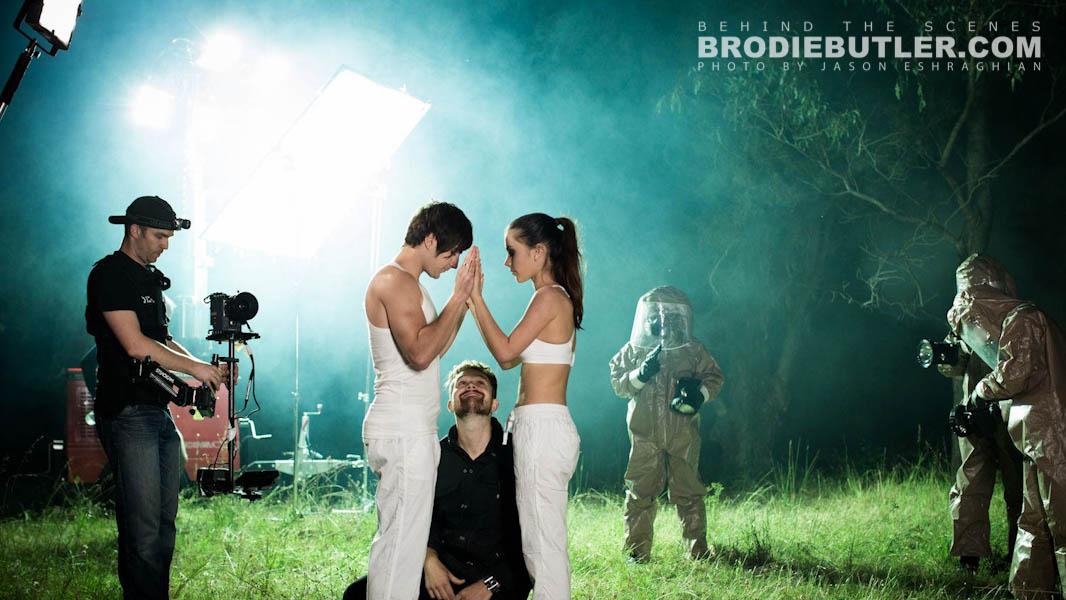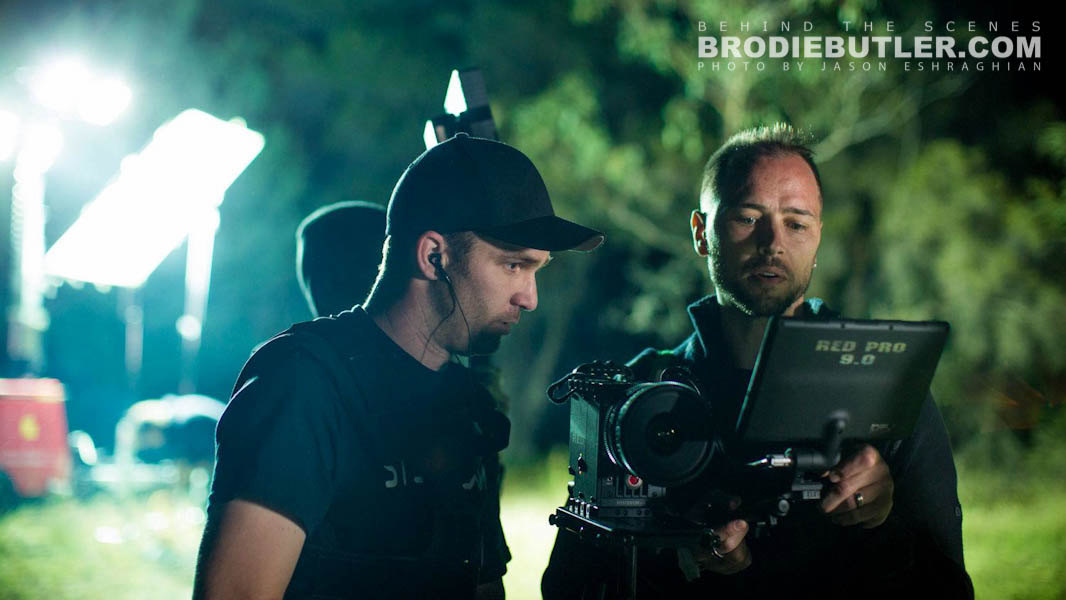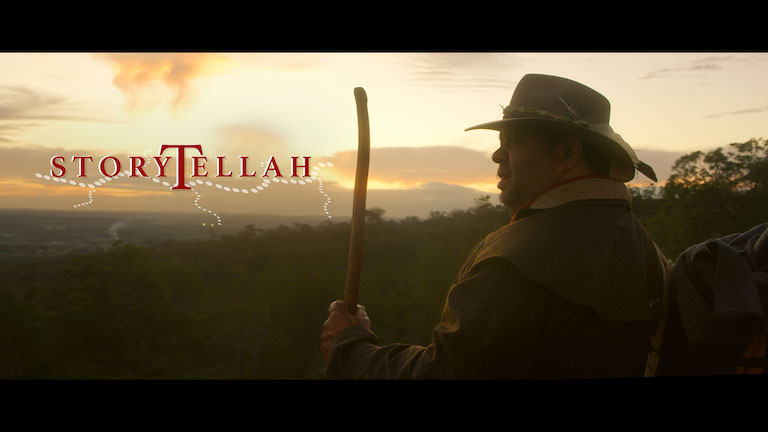This was a very exciting day for me. Not only did I get my hands on an actual RED camera for the first time, but I discovered that my baby steadicam rig consisting of a Glidecam HD4000 supported on a STEADICAM Merlin Arm & Vest, was actually capable of flying a RED camera! I never even considered it to be possible, and to be honest until recently it hasn’t been. There’s no way my Steadicam setup could support a RED One camera as it is way too heavy. The body alone is a block of Aluminium weighing in at 4.5kg (10lbs). Then to actually film anything you need to add a lens mount and an actual lens to that, as well as a memory card and battery and thats just the bare minimum and would be much more weight than my rig could handle.
WHAT IS A RED?
For those that don’t know, RED Digital Cinema are one of the industry leaders in high end digital cinema cameras and their camera products are used on the largest of film & TV productions around the world including popular films you might know such as The Book of Eli, The Hobbit, The Amazing Spiderman, Pirates of the Carribean and many, many more. http://www.red.com
In more recent times the RED Cinema Cinema company have produced more compact smaller versions of it’s leading digital cinema camera, producing the RED SCARLET(above) and RED EPIC cameras. These camera bodies weigh in at only half of the bigger brother RED ONE at just 2.23kgs (5lbs). To my suprise, I am actually able to fly the RED SCARLET and the RED EPIC (which are identical bodies) on my steadicam rig. Due to the weight restrictions I am limited to the bare essentials of just a body and lens. So we had to strip it. I don’t have the luxury of being able to add a remote follow focus, feed transmitters, or even rails and a mattebox to use filters. I really do mean the bare essentials to make this possible with my rig.
 Fortunately for me, there are still plenty of applications where a simple camera and lens are all you need to get amazing shots. It’s a bonus that Steadicams are often used with a wider lens so focus is much easier to hold on your subjects without requiring a remote follow focus unit and a focus puller. Wider lenses also generally means a smaller/lighter lens which works in my favour. We used this RED 18-50mm lens in the photo (left) and the Zeiss Compact Primes which were even lighter again. The Zeiss compact primes were perfect. The RED 18-50mm was just a tad too much weight.
Fortunately for me, there are still plenty of applications where a simple camera and lens are all you need to get amazing shots. It’s a bonus that Steadicams are often used with a wider lens so focus is much easier to hold on your subjects without requiring a remote follow focus unit and a focus puller. Wider lenses also generally means a smaller/lighter lens which works in my favour. We used this RED 18-50mm lens in the photo (left) and the Zeiss Compact Primes which were even lighter again. The Zeiss compact primes were perfect. The RED 18-50mm was just a tad too much weight.
The RED Scarlet has a HDMI output so I was able to send a feed straight into my SmallHD DP6 monitor. I have been in love with this monitor ever since they came out and I have predominantly used it with my 5DMKII and 5DMKIII. It was great to try it out with a RED and the two got along just fine.
I had to play around with a couple settings to get the full frame from the Scarlet of what I was shooting but in the end it worked out perfectly. The SmallHD has some focus assist features but the RED itself has some even better ones and I was able to push those onto the feed on my monitor and focus was a piece of cake the whole night of filming. The SmallHD DP6 is a huge benefit in this scenario because I can save on weight. It’s just so light, but the best part is that I don’t need another battery rigged up. By using lightweight LP-E6 batteries (from 5DMKII/III) to power the monitor via the SmallHD adapter that clips straigth on the back I can save even more weight and space and the monitor will run for hours. Thumbs up SmallHD.
I mounted the battery plate and battery (to power the Scarlet) on the base of the glidecam as you can see below. To do it quickly we resorted to some good old fashioned electrical tape (didnt have any gaffa tape or cable ties handy, we switched to solid gaffa tape on the night of filming though). The battery was originally mounted to the back of the camera but it made the glidecam way too top-heavy which would mean I would have to add much more weight to the bottom to try and balance it out. That wasn’t going to be possible, as I was already pushing the weight boundaries. So this worked out well relocating it to the bottom.
The Steadicam Merlin Arm and vest was JUST capable of supporting the weight. I think the rig all up weighed 10kg’s (approx 22lbls). To be able to support the weight I had to tension the springs in my Steadicam arm all the way up. Just a note to fellow Steadicam users out there, this is much more than the manufacturer weight recomendations which I beleive are at 16lbs for the Steadicam merlin arm. I was operating with this extra weight under the assumption that there are manufcturer safety factors involved and that we could probably run additional weight over the recommendation for a limited period of time. I have seen reports of operators flying over the recommended weight also.
I was sure to rest the arm between takes (as well as my back) and release the tension in the springs when I was done.
Overall the Glidecam seemed to handle it alright and so did the Merlin Steadicam arm and vest. It’s all still in one piece!
So what was this all for? What was I filming? I was out filming the Australia’s Got Talent sensation “Beside Lights” brand new music video. I’m not allowed to say too much or reveal too much, but here are some sneak peek behind the scenes photos from filming. Thanks to Jason Eshraghian for the set photos!

Check out some more photos of the RED Scarlet Steadicam Rig in Perth below as well as some more behind the scenes photos from the Besides Lights music video Directed by Tim Brade.










6 Comments
Hi, I just purchased the HD4000 and a 5D3. What would be the optimum lens for this set-up? I am leaning toward the 24mm f 2.8 IS lens (due to its stabilization).
Thanks!
@Joel – I’ve found the 5D3 / HD4000 combo works well with the 24-70 and also the 16-35 giving you a nice coverage of focal lengths. I usually shoot with a battery grip for extra life and it still holds the weight well including rails/light matte box and a 7″ monitor thrown into the balance
Great to see. I have access to a scarlet for a few days and currently do a lot of 5DMK3 video on the HD4000, I’m presuming you need the added arm and support vest to use the scarlet on the glidecam? As in I wont be able to just throw the red on the glidecam and hold it with the handle like I currently do? My arm’s aren’t invincible.
Absolutely not Ben. You definitely need an arm and I wouldnt recommend the Steadicsam Merlin arm like I have, I would recommend an arm that can take much more weight.
Even a 5DMKIII and a decent lens is too much to handhold properly. You need to be concentrating on your framing and balance, not on trying to hold the thing up!
While you can get away with handholding a 5D, you wont getaway with handholding a red.
This is a very very late comment, but do you have any advice when it comes to the necessity of a vest when flying a 5D MKIII and a 24-70? Will I get smoother shots with a vest or is it just to help on longer takes?
I’m considering a Glidecam HD4000, potentially with vest, or a Blackbird stabiliser. Help?
There’s no reason why you cant get perfectly smooth shots without a vest. If you’re filming a lot though you’re arm is going to get sore and tired and start shaking on takes. The vest allows you to relax and focus on the camera movement, without worrying about holding the thing up. I always use my vest at every opportunity.